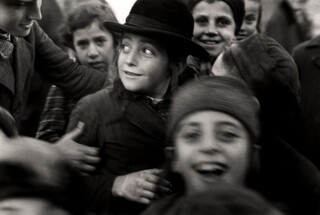At the Jewish Museum and the Photographers’ Gallery
Daniel Trilling
An exhibition split between the Jewish Museum and the Photographers' Gallery – until 24 February; there’s still time, just, to go this weekend if you can – revisits the work of Roman Vishniac, best known for recording the lives of Eastern European Jews in the years immediately before the Second World War.
Born in Russia, displaced first to Berlin in 1920 and then New York in the 1940s, Vishniac produced a series of portraits of daily life – in city neighbourhoods of Warsaw, Krakow and Lublin; in the villages of Ruthenia and the towns of the Carpathians – just as these communities were about to be wiped from existence by the Nazis and their collaborators. He photographed people in their homes, at work, walking in the street, or in their schools and places of worship. His photographer’s eye mixes a gentle European modernism – the angles of buildings or the play of light and shade turned into geometric patterns – with a concern for the specifics of the individual: bodies at rest or in motion, or faces that look directly into the camera, their emotions ambiguous.
Many of Vishniac’s photographs were commissioned by Jewish relief agencies hoping to solicit donations from the diaspora, or provoke political leaders into action. Their intention was not to prevent the Holocaust – the kind of retroactive fantasy it can be tempting to apply to history – but to intervene in a messy and changing situation. Vishniac was representing communities who had been variously displaced by war, oppressed by poverty, or targeted by racist boycotts and exclusionary state policies. Displayed like this, the photographs evoke the confusion of events as they unfolded.
In 1938, the German government tried to deport 17,000 Jews of Polish origin. Poland refused to accept them, and around 9000 people were stranded in the border town of Zbąszyń. Vishniac’s pictures of people in filthy barracks accommodation or clustered around makeshift outdoor kitchens could almost be images made in parts of the world today. They capture the limbo in which displaced and marginalised people are often forced to live, but also deliberately employ the common visual language of humanitarianism: pathos, helplessness, a sad child’s face.
By the time many of Vishniac’s photos reached public display, via the Yiddish cultural institute YIVO in New York, in 1944 and 1945, their main purpose had already shifted: no longer living documents but memorials. The exhibition in London shows a fuller range of Vishniac’s photos than those he selected for display, and the rejected ones are more revealing. He tended to favour the more obviously symbolic images, or the ones that were more identifiably ‘Jewish’ – male, bearded shopkeepers rather than their female counterparts, for instance, or sentimental scenes of poverty. In the rejects, the framing often isn’t as neat, or the poses and behaviour are more casual and everyday. But I thought these captured something raw and unsettling: life going on.
The most memorable images, for me, however, come from an earlier series: Vishniac’s long-term project to document Berlin street life, which he began in the 1920s. After 1933, the Nazis made it almost impossible for Jewish photographers to find work, and it was dangerous for them to be seen taking professional photos in public. Vishniac continued, but pretended to be taking tourist snaps. Some look banal – blurry shots of people walking down a sunny city street – until you see the swastika flags fluttering from a shop in the corner of the frame.
For others, Vishniac used his daughter Mara as camouflage, getting her to pose for portraits but with his mind on what was behind her. In one, she stands in her winter coat and hat in front of a poster of Hitler and Hindenburg that exhorts the public to ‘fight with us for peace and equal rights’. In another, she stands in front of a shop offering a skull-measuring service to prove your ‘Aryan’ heritage. The subject matter is chilling enough, but what gets you is the interplay between these elements and Vishniac’s daughter: a girl of nine or ten, quizzical and half-smiling in one photo; looking annoyed in another. Whatever else these are, they’re a record of a father bossing his child around on a day pretty much like any other, a lifetime ago.



Comments
The Exhibition has a photo of David Eckstein as a schoolboy at a Carpathian cheder. He was a Holocaust survivor and decades later identified with the photo; he recorded his memories of his experiences as a child and as a deportee captured on YouTube.
That ‘election’ was actually a referendum to enable Germany to exit international organisations and obligations. I was completely unaware that the Nazis embarked in this way, before they had achieved absolute power.
May I stop there ?